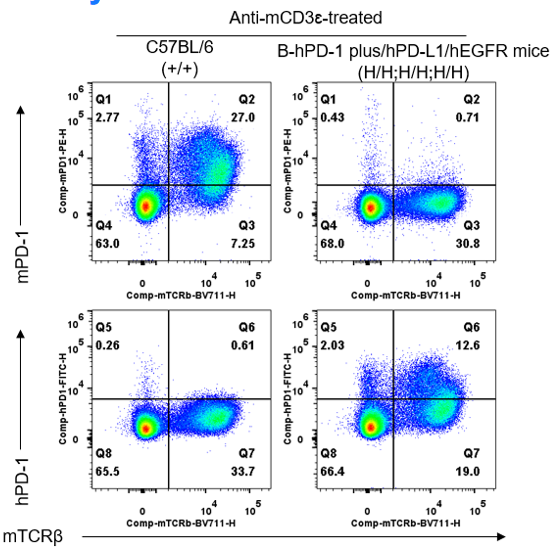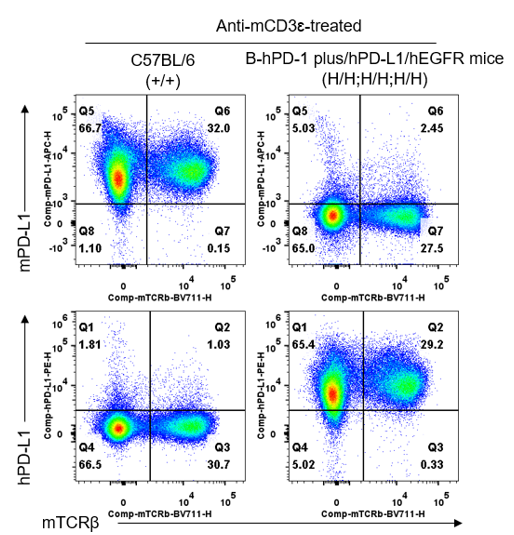


C57BL/6-Pdcd1tm3(PDCD1)Bcgen Cd274tm1(CD274)Bcgen Egfrtm2(EGFR)Bcgen/Bcgen • 113031
| Product name | B-hPD-1 plus/hPD-L1/hEGFR mice |
|---|---|
| Catalog number | 113031 |
| Strain name | C57BL/6-Pdcd1tm3(PDCD1)Bcgen Cd274tm1(CD274)Bcgen Egfrtm2(EGFR)Bcgen/Bcgen |
| Strain background | C57BL/6 |
| NCBI gene ID | 18566, 60533, 13649 (Human) |
| Aliases | PD-1, CD279, hPD-l, hSLE1, PDCD1, SLEB2, PD1, hPD-1, CD274, PDL1, B7-H, B7H1, PDCD1LG1, PD-L1, PDCD1L1, hPD-L1, ERBB, HER1, mENA, ERBB1, PIG61, NISBD2 |
Gene targeting strategy for B-hPD-1 plus/hPD-L1/hEGFR mice.
Human PD-1 gene encoding the extracellular region and mouse Pd-1 gene encoding the transmembrane and cytoplasmic region were inserted after the initiation codon ATG of mouse Pd-1 gene in B-hPD-1 plus/hPD-L1/hEGFR mice.
The exon 3 of mouse Pdl1 gene that encodes the IgV domain was replaced by human PD-L1 exon 3 in B-hPD-1 plus/hPD-L1/hEGFR mice.
The exons 2-17 of mouse Egfr gene that encode extracellular domain were replaced by human counterparts in B-hPD-1 plus/hPD-L1/hEGFR mice. The genomic region of mouse Egfr gene that encodes transmembrane domain and cytoplasmic portion was retained. The promoter, 5’UTR, signal peptide and 3’UTR region of the mouse gene were also retained. The chimeric EGFR expression was driven by endogenous mouse Egfr promoter, while mouse Egfr gene transcription and translation will be disrupted.

Strain specific analysis of EGFR, PD-1 and PD-L1 mRNA expression in wild-type C57BL/6 mice and B-hPD-1 plus/hPD-L1/hEGFR mice by RT-PCR. Spleen and heart RNA were isolated from wild-type C57BL/6 mice (+/+) and homozygous B-hPD-1 plus/hPD-L1/hEGFR mice (H/H;H/H;H/H), then cDNA libraries were synthesized by reverse transcription, followed by PCR with mouse or human EGFR, PD-1 and PD-L1 primers. Mouse Egfr, Pd-1 and Pd-l1 mRNA were detectable only in wild-type C57BL/6 mice. Human EGFR, PD-1 and PD-L1 mRNA were detectable only in homozygous B-hPD-1 plus/hPD-L1/hEGFR mice but not in wild-type mice.

Strain specific PD-1 expression analysis in wild-type C57BL/6 mice and homozygous humanized B-hPD-1 plus/hPD-L1/hEGFR mice by flow cytometry. Splenocytes were collected from wild-type C57BL/6 mice (+/+) and homozygous B-hPD-1 plus/hPD-L1/hEGFR mice (H/H;H/H;H/H) stimulated with anti-mouse CD3ε antibody (7.5 μg, i.p.) in vivo for 24 hrs. Protein expression was analyzed with anti-mouse PD-1 antibody (Biolegend, 109104) and anti-human PD-1 antibody (Biolegend, 329904) by flow cytometry. Mouse PD-1 was only detectable in wild-type C57BL/6 mice. Human PD-1 was exclusively detectable in homozygous B-hPD-1 plus/hPD-L1/hEGFR mice, but not in wild-type C57BL/6 mice.

Strain specific PD-L1 expression analysis in wild-type C57BL/6 mice and homozygous humanized B-hPD-1 plus/hPD-L1/hEGFR mice by flow cytometry. Splenocytes were collected from wild-type C57BL/6 mice (+/+) and homozygous B-hPD-1 plus/hPD-L1/hEGFR mice (H/H;H/H;H/H) stimulated with anti-mouse CD3ε antibody (7.5 μg, i.p.) in vivo for 24 hrs. Protein expression was analyzed with anti-mouse PD-L1 antibody (Biolegend, 124312) and anti-human PD-L1 antibody (Biolegend, 329706) by flow cytometry. Mouse PD-L1 was only detectable in wild-type C57BL/6 mice. Human PD-L1 was exclusively detectable in homozygous B-hPD-1 plus/hPD-L1/hEGFR mice, but not in wild-type C57BL/6 mice.

Immunohistochemical (IHC) analysis of EGFR expression in homozygous B-hPD-1 plus/hPD-L1/hEGFR mice. The liver and kidney were collected from WT and homozygous B-hPD-1 plus/hPD-L1/hEGFR mice (H/H;H/H;H/H), analyzed by IHC with anti-EGFR antibody. Mouse EGFR was detectable in WT mice, and human EGFR was detectable in homozygous B-hPD-1 plus/hPD-L1/hEGFR mice. The arrow indicates tissue cells with positive EGFR staining (brown).